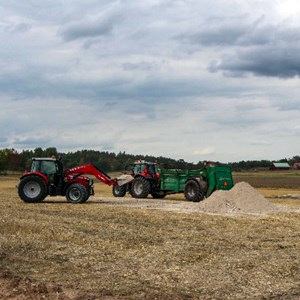Structural liming

Structural liming of clay soils gives benefits both for waters and for the farmer. A soil with good structure is easier to cultivate and may also increase productivity due to better water and nutrient retention capacity.
Structural liming is a measure that improves soil structure in clay soils. Calcium ions in the lime interact with the clay minerals and builds porous aggregates. With better soil structure the water infiltration capacity increases and hence the risk for surface runoff and erosion. Also reduced is the risk for shrinking and establishment of crack structures where water can erode soil particles. Erosion of soil particles could be a major source to phosphorus losses from clay soils.
Localisation and implementation
Well-functioning field drainage and a clay content of at least 15% are prerequisite. For best effect, the time for structural liming is directly after harvest when the soil moisture content is low and temperature is high. Incorporation in the soil immediately after spreading is also important. The type of lime and doses varies among regions depending on sources and prices.
Effects, duration and maintenance
Improved water infiltration capacity, reduction of phosphorus losses and potential for improved productivity are main outcomes of structural liming. Biological activity in the soil may increase which means more biodiversity and higher soil organic content.
The effect is long-term if soil condition during implementation is optimal. After incorporation, no maintenance is needed.

Structural liming - links to resources
Pamphlets, reports, videos and websites
Video "Så kalkar du dina åkrar" (SE)
Broschure on structural liming (SE)
Wikipedia: Liming of soil
Scientific papers
Blomquist, Jens; Simonsson, Magnus; Etana, Ararso; Berglund, Kerstin (2018-05-19). "Structure liming enhances aggregate stability and gives varying crop responses on clayey soils". Acta Agriculturae Scandinavica, Section B — Soil & Plant Science. 68 (4): 311–322. DOI
Author:
Katarina Kyllmar, Swedish University of Agricultural Sciences, Sweden.
